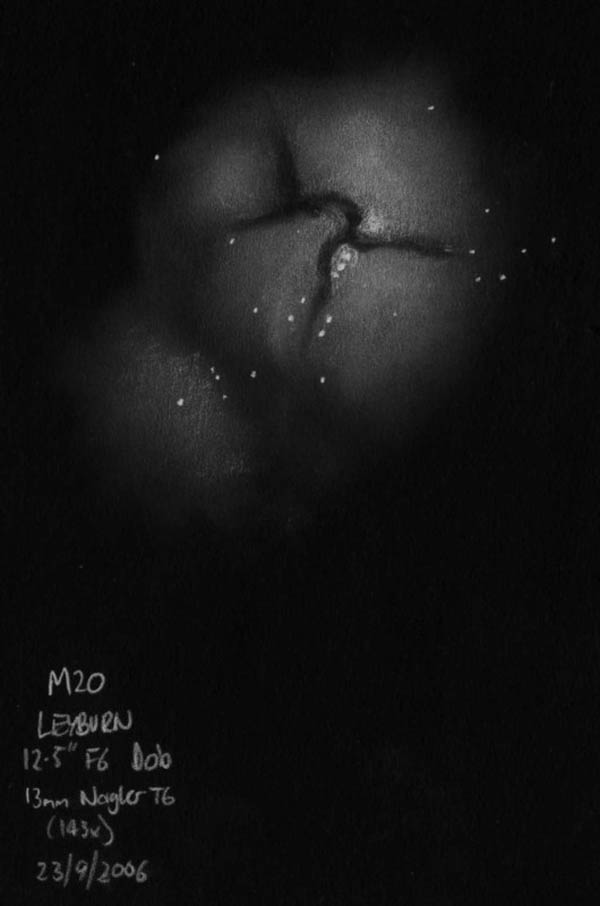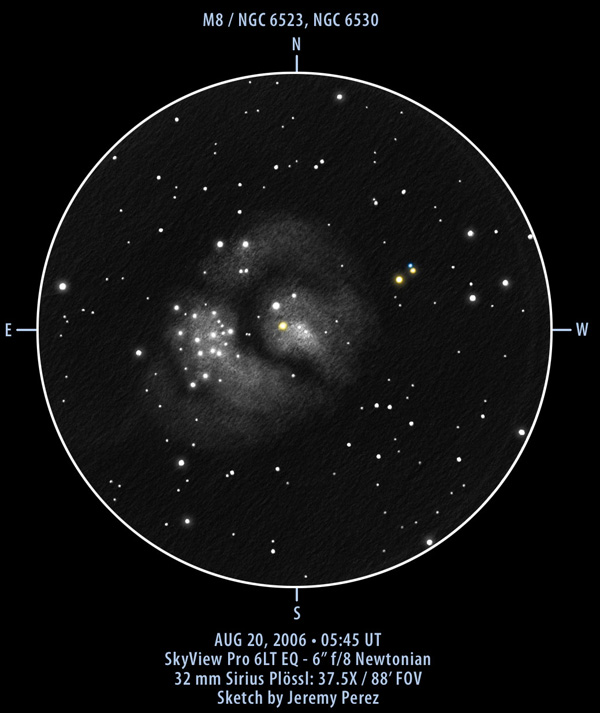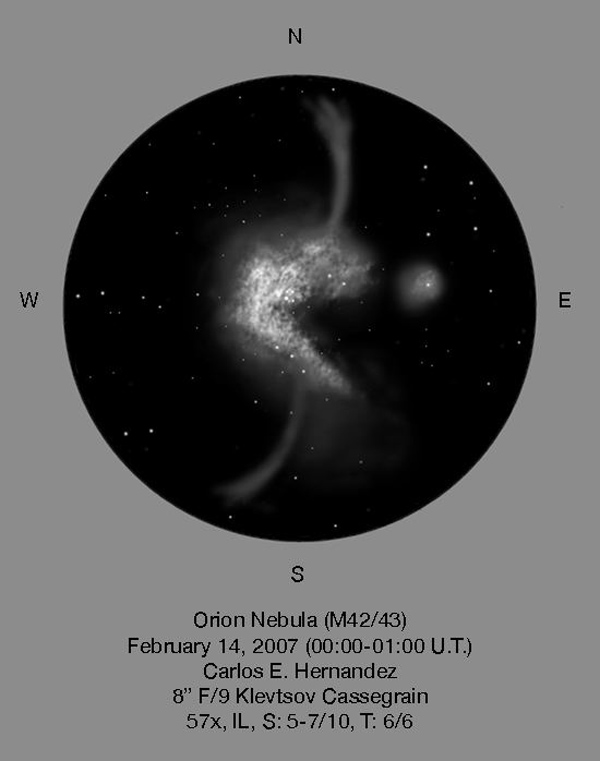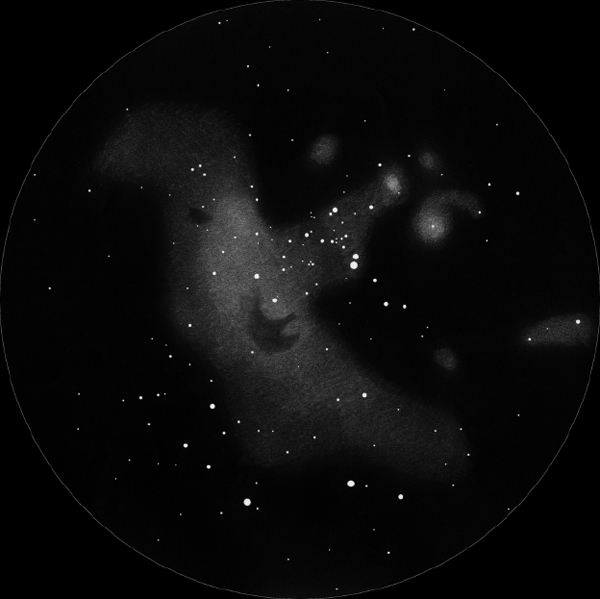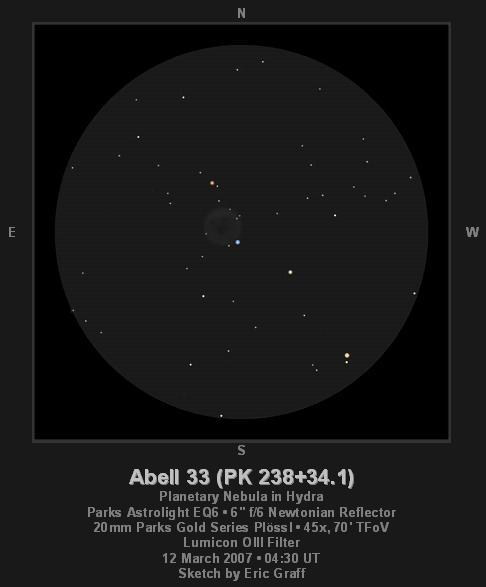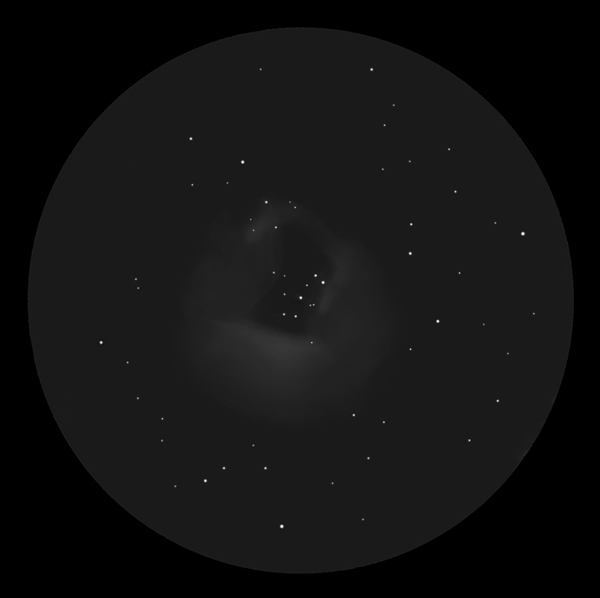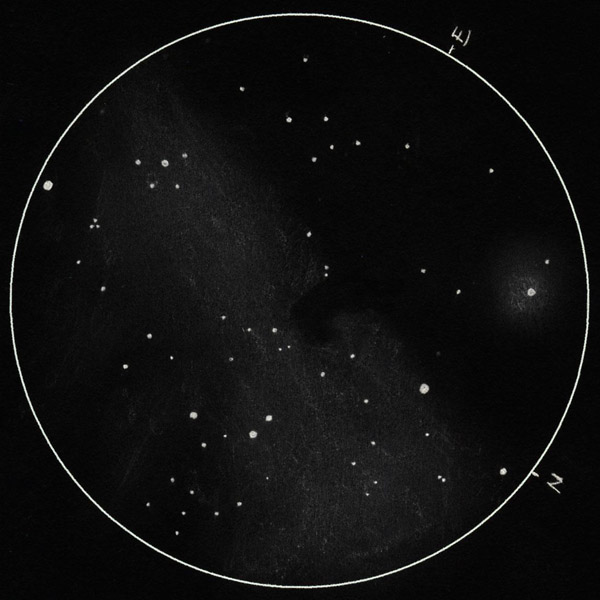Information about sketch:
Sketch is of M20 – the Trifid Nebula
Done on the 23rd of September last year
Drawn completely at the eyepiece of a 12.5″ f6 dob using a 13mm T6 Nagler
for around 143x. It was done on white sketch pad paper using a graphite
pencil. The sketch was then scanned and converted to the negative in
Irfanview.
Cheers
Andrew Durick
Brisbane, Australia
Category: Nebulae
When an iron heart stops beating
Messier 1
Meade Lx90 10″
167x
Seeing/Transparancy- Average
NELM- 5.8
Medium- Graphite
Sal Grasso
In the year 5,246 B.C., a star with a mass about three times that of our Sun was losing its life-long struggle with gravity. It had burned the hydrogen and helium in its core long ago and had begun burning ever more heavy elements until it reached iron, an energy absorbing reaction. Without the radiative core emitting enough energy to sustain a balance between gas pressure and gravitation, there was to be only one result. The crushing weight of the star’s atmosphere would collapse upon its iron core. The rebound energy would then produce a titanic explosion that would blow the star’s atmosphere into space and produce an intensely ferocious burst of neutrinos, gamma, x-ray and optical radiation. As it happened the stellar core would collapse even further (via implosion) and the electrons would be forced into very close proximity to protons, causing them to become neutrons. Only neutron degeneracy, an aspect of the Pauli Exclusion Principle and the star’s initial mass prevented the runaway collapse to a black hole. In this compact state, a city sized 10 km sphere contains the entire mass of the Sun and rotates at a dizzying 30 times per second. Retaining a strongly intensified magnetic field, it sends pulses of radiation from its magnetic poles at very regular intervals as it rotates.
Six thousand three hundred years later, in 1054 A.D., Chinese astronomers took note of the position of a visitor star in the constellation of Taurus, the Bull. 953 years later, this visitor star is now seen as an expanding cloud of gas fully 12 light years wide. The rate of expansion is actually faster than the calculated rate for a free explosion, a result that indicates the intense magnetic environment accelerates electrons to relativistic velocities thus providing the energy for this “accelerated” expansion. Current measurements indicate that the complex filaments that thread the nebula are expanding at approximately 1000 meters per second.
Buried treasure in a deep Lagoon
M8 was on my list of “ambitious” sketches to draw (or redraw) for a couple years before I finally managed to tackle it. On my first attempt, I got skunked by clouds before I could finish the star field. I came back a couple nights later, and the outflow of clouds from a thunderstorm to the east threatened to bring things to a halt again. But I was patient and managed to wait out the weather.
This is such a rich and well-lit nebula/cluster, that it’s hard not to just relax and feast on its visual delights. But I had decided I was going to turn this one into a project. I wanted to capture the cluster and field stars as accurately and deeply as possible. This in itself can be a pretty tedious process, but the regular blackouts caused by interloping clouds made it very aggravating. Especially since I was doing the observation pretty late in the season, and Sagittarius was threatening to set on me. Observing shouldn’t be aggravating. Tedious from time to time, sure. But not aggravating. I was being stubborn
though, and I kept plugging along. An hour and 40 minutes later I was satisfied I had captured all I could, and as if on a merciful queue, the clouds went ahead and made a permanent home over the southwestern sky.
Something I find very interesting about the embedded cluster NGC 6530 is the grid-like geometry of its stars. It seems to bear an amplified kinship to the squared angles of M29–a junior sized favorite of mine. The UltraBlock (~UHC) filter does a great job of defining the boundaries and clots of brightness in the nebula, but I find the unfiltered view to be the most pleasing. Without the filter, the view is thickly seasoned with Milky Way field stars and the members of the open cluster just seem to nestle and burn themselves in their folded blanket of nebulosity. I noted some star color in a few places, and these are depicted in the sketch.
I created the base for this sketch on Strathmore sketch paper using 2H graphite for the initial star field. I then switched to HB graphite for the brighter stars. I then brushed in the nebulous regions with a blending stump loaded with graphite. Afterward, I replotted any stars that were blurred or diminished by the blending process.
After scanning the sketch and inverting it from negative to positive, I used a soft, transparent brush to add glow around the brighter stars. I then used a soft, transparent brush set to ‘color’ mode to apply color to the stars I had noted during my observation. Although I believe it is possible to overwork a sketch with digital tools, when care is taken not to overdo it, I’ve found these extra techniques very useful. In this case, I believe it helps to pop the brighter stars out as they appeared in the eyepiece. I feel it was particularly helpful for the core cluster stars that nestle in the nebula. In my opinion, that extra bit of glow helps merge them with the nebula and conveys the sense that they really are lighting it up, as it appeared through the telescope. Finally, the perception of color is an important part of my observations, and I feel that careful addition of color on the computer can handle this very nicely.
Object Information:
There are two main objects that compose this object. NGC 6530 which is the open cluster of stars, discovered in 1680 by Flamsteed. The nebula that these stars are imbedded in, NGC 6523, was discovered by Le Gentil in 1747. When Charles Messier catalogued it in 1764, he primarily described the cluster, and mentioned the nebula separately as surrounding the star, 9-Sagittarii. However, the nebula is now generally regarded as M8.
The distance to M8 is believed to be from 4850 to 6500 light years. If the distance given by David Eichler of 5200 light years is correct, then the nebula measures 140 x 60 light years across. The brightest portion of the nebula contains a region known as the Hourglass Nebula, which is region currently undergoing new star formation. There are also a number of dark nebulae known as globules in the Lagoon. These are collapsing protostellar clouds with diameters of about 10,000 AU.
Subject: M8/NGC 6523, 6530
Classification: Diffuse Nebula and Open Cluster
Position: Sagittarius [RA: 18:03:41.2 / Dec: -24:22:49]*
Size*: 90′ x 40′
Brightness*: bMag 5.0
Date/Time: August 19, 2006 – 10:45 PM MST (August 20, 2006 – 05:45 UT)
Observing Location: Anderson Mesa, AZ
Instrument: Orion SVP 6LT Reflector (150 mm dia./1200 mm F/L)
Eyepieces/Mag. 32 mm Sirius Plössl (37.5X)
Seeing: 3/10 Pickering
Transparency: Mag 6.8+ NELM
*Sources: SEDS, NGC/IC Project
Cradle of the stars
The Orion Nebula (M42, NGC 1976) is one of the most well known and observed nebulae in the heavens. This magnificent collection of gas and dust visible as the “middle star” of the sword of Orion measures 30 light years across and lies approximately 1,500 light-years away. The Orion Nebula represents a stellar nursery in which stars are formed from the accretion of hydrogen gas and dust into protoplanetary disks (or proplyds) as imaged by the Hubble Space Telescope (HST).
I made wide-field observation of the Orion Nebula on February 14, 2007 using an 8-inch (20 cm) F/9 Klevtsov-Cassegrain reflector (a catadioptric design employing a sub-aperture meniscus correcting lens combined with a Mangin mirror-lens secondary). The observation was made under very transparent (6/6) and steady (5-7/10) conditions. The core of the nebula appeared brilliant in the field containing the famous Trapezium. Fainter extensions were noted to project from the core, including elongated ones to the north and south. The rendering was initially made using graphite (6H to HB) on Bristol Board paper (smooth), scanned into Photoshop and reversed.
Carlos E. Hernandez
A star in the guise of a comet
Here is a sketch of NGC 2261, the Hubble’s variable nebula.
Some informations :
– Telescope : Dobson Lukehurst 495/2032, Pentax XW 7 mm (x290), no filter.
– Date : 30/10/06, 04:00 UT.
– Place : Nailly, Yonne, France.
– Sky : not transparent (lim. magnitude about 5,0) but with very good seeing.
A draft was made during the observation, then I made two sketches : one with the stars, the other with the nebula (on a white paper and with a lead pencil). Then, I scanned the two sketches and saved negative pictures. The picture with the nebula was colored in a light green. And finally, I added the two images. The sketch is not perfect : the east side of the nebula was more luminous than the west side – it is not obvious in the sketch. But the color of the nebula seems (to me) well shown.
Bruno Salque
Here’s a link to a archived post on Astronomy Picture of the Day that discusses some of the fascinating aspects of Hubble’s variable nebula.
Resplendent raptor
M16 Eagle nebula
This nebula was drawn with graphite pencils on
white paper and then inversed after scanning.
The main field stars (until about magnitude 11)
was printed with a charting software and the
fainter stars and nebula were added during the
observation. It took about an hour to lay all the
details on paper.
17.5-inch dobsonian, F/4.5, 74 &125x, OIII filter
used for the fainter parts; 15/august/2004,
22h00UT, good transparency (visual limit of 6.31
in UMi); from La Clapière in the french alps at
an elevation of 1650m.
Yann Pothier
Stellar spirit
Ghost of a dying star
In the western reaches of elongated Hydra, near the western border of Sextans you will find a ragged string of four stars ranging in magnitude from 6 to 8 aligned northeast to southwest located 1.7° south of 4th magnitude Iota Hydrae and 2.5° east of 5th magnitude Tau1 Hydrae (a fine, widely spaced double star). The third star from the west (and slightly out of line with the other three stars) is 7th magnitude HD 83535. This bluish-white star is superimposed on the edge of a ghostly planetary nebula known as Abell 33. My best view of this limpid pool of nebulosity was achieved with a 20mm Plössl (yielding a magnification of 45x) and an OIII filter. This setup revealed a small faint disk of tenuous nebulosity about 4½’ in diameter in contact with the 7th magnitude star on its southwest edge. The edges of the disk were reasonably sharp and the brightness faded gradually toward the darkened center. At other magnifications (both with and without the filter) the view was less distinct and the nebula became almost impossible to detect at magnifications above 60x. The 16th magnitude central star was not visible, but a trio of 13th magnitude stars (two of them a close pair) are perched on the northwestern edge of the nebula.
Abell 33 was discovered on Palomar Observatory Sky Survey plates by George O. Abell and published in the April 1966 Astrophysical Journal (Abell 1966). These nebulae, being very faint and of relatively large angular size are classified as ‘old’ or ‘evolved’ planetary nebulae. Observing the 86 objects in Abell’s catalogue constitutes one of the supreme observing challenges for amateur astronomers with large-aperture scopes; fortunately a few of them, including this one, are accessible in fairly modest equipment provided the observer has access to very dark skies and an OIII filter. Recent estimates place Abell 33 at a distance of about 1,100 light years from Earth (Phillips 2005), which implies an actual diameter of about 1.4 light years.
Subject: Abell 33 (PK 238+34.1)
Object Type: Planetary Nebula
Constellation: Hydra
Right Ascension (2000.0): 09h 39m 09.1s
Declination (2000.0): -02° 48′ 31″
Magnitude: 12.4n/15.7s
Diameter: 268″
Classification: 2b
Observer: Eric Graff
Location: Cuyamaca Mts., San Diego Co., California (4,000 ft. elevation)
Date & Time: 12 March 2007 at 04:30UT
Transparency: NELM 6.7, TLM ~14.1
Seeing: Pickering 5-6/10
Telescope: Parks Astrolight EQ6 (6″ f/6 Newtonian Reflector)
Eyepiece: 20mm Parks Gold Series Plössl (45x, 70′ TFoV)
Filter: Lumicon OIII Filter
Sketching Materials: #2 pencil, black ink, blending stump, 24# copy paper
References:
Abell, George O. 1966. Properties of Some Old Planetary Nebulae. Astrophysical Journal. 144:259-279.
Philips, J.P. 2005. The distances of highly evolved planetary nebulae. Monthly Notices of the Royal Astronomical Society. 357:2:619-625.
A rose by any other name
The Rossette nebula, NGC 2237-8, 46
Here is a challenging object. It was at the threshold of visibility for me and my gear. The nebulae was visible at a power of 12.5 (40mm EP) and at 19x (26mm EP). It vanished at any higher power!! The sketch was made with help of a lumicon UHC filter. But the most significant aid in detecting the ghostly glow was wobbling the scope left and right. The eye is more sensitive to moving ghosts than to steady
ones. As a result of the UHC filter, the fainter stars are lost. But I wanted to concentrate on the nebulae. The sketch was made in Photo-Paint, based on a raw pencil-sketch behind the scope. I hope you like the view.
Rony De Laet
Sketch data:
Date : March 9, 2007
Time : 21.00UT
Scope : Skywatcher 102/500
EP : 26mm SP
Power : 19x
FOV: 2.7°
Filter : Lumicon UHC
Seeing : 3/5
Transp. : 2.5/5
Sketch Orientation : N down, W left.
A dark horse
The Horsehead nebula is among the most photographed denizens of the deep-sky. But it is rarely the subject of a visual observation, much less a sketch. I made this observation the night of January 20, 2006, almost ten years to the day after my first observation of this ellusive object. Formally designated Barnard 33 (B33), the Horsehead is a dark nebula seen in the foreground of the delicate emission nebula IC 434. The contrast between IC 434 and the Horsehead is quite subtle; like a whisper in the night. But as long as the sky darkness and transparency are good, a 6-inch aperture is up to the task of seeing the famous Horsehead. On this night, the view in my 18-inch Obsession was truly stunning. Even unfiltered, the inky black form of B33 was obvious at 109X (22-mm Nagler Type 4 w/ Paracorr). My sketch represents a combination of two views. The first was unfiltered to reveal as many field stars as possible. The second was with a Lumicon hydrogen-beta (H-beta) filter in place to record the full glory of the B33/IC 434 complex. The Horsehead cuts into IC 434 along the nebula’s eastern edge. It is distinctively darker than the surrounding sky, having a genuine inky blackness as if someone has carelessly left the tip of their quill too long against the sky. The back of the horse’s neck, head, brow, and snout are all discerned. Some 60 stars frame the view.
I used HB and 2B Staedtler Mars Lumograph graphite pencils to make the drawing on a sheet of white printer paper. Gentle rubbing with the tip of my right index finger lended softness to the background nebulosity.
Bill Ferris
Flagstaff, Arizona

